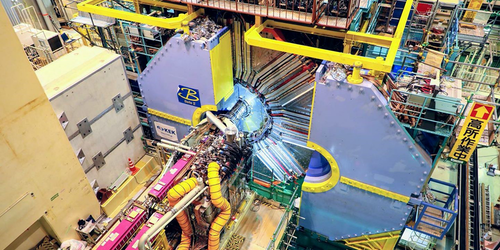Closing in on the Z′ Boson
Along with the Z0 boson, physicists propose the existence of a second neutral boson, Z′, that could connect dark matter and the standard model. Its existence could also potentially explain certain puzzles present in standard model physics. Searches for this boson are ongoing at experiments around the world, including at Belle II at the SuperKEKB accelerator in Japan. Announcing its first results, the Belle II Collaboration reports finding no sign of the Z′ boson. The team does, however, place constraints on the coupling constant that describes how strongly this hypothetical particle could interact with known standard model particles.
In the experiments, the Belle II team collided electrons and positrons. Predictions indicate that a collision between an electron and a positron can produce a Z′ boson and that this boson should then decay into two neutrinos or into dark matter particles. Analyzing data that it collected in the spring of 2018, the collaboration found no sign of the Z′ boson. The absence of the boson did, however, let the team rule out some values of g′, the coupling constant that describes how strongly the Z′ boson should interact with standard model particles.
With more data, the Belle II Collaboration says that it will be able to further constrain the value of the coupling constant. Doing so could allow the researchers to determine whether the strength of the Z′ boson interaction alone might explain why the measured anomalous magnetic moment of the muon is higher than the standard model predicts. Researchers say that this longstanding discrepancy between experiments and theory likely hints at new physics—whether that’s the Z′ boson or something else.
This research is published in Physical Review Letters.
–Erika K. Carlson
Erika K. Carlson is a Corresponding Editor for Physics based in Brooklyn, New York.




